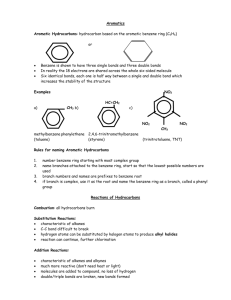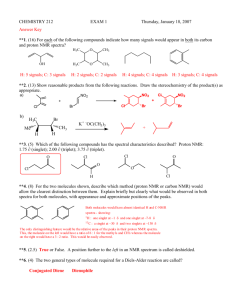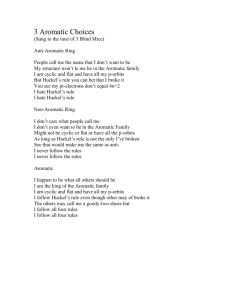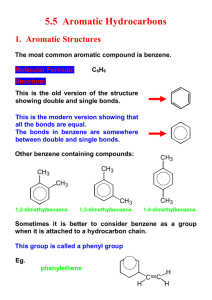Chapter 15
advertisement
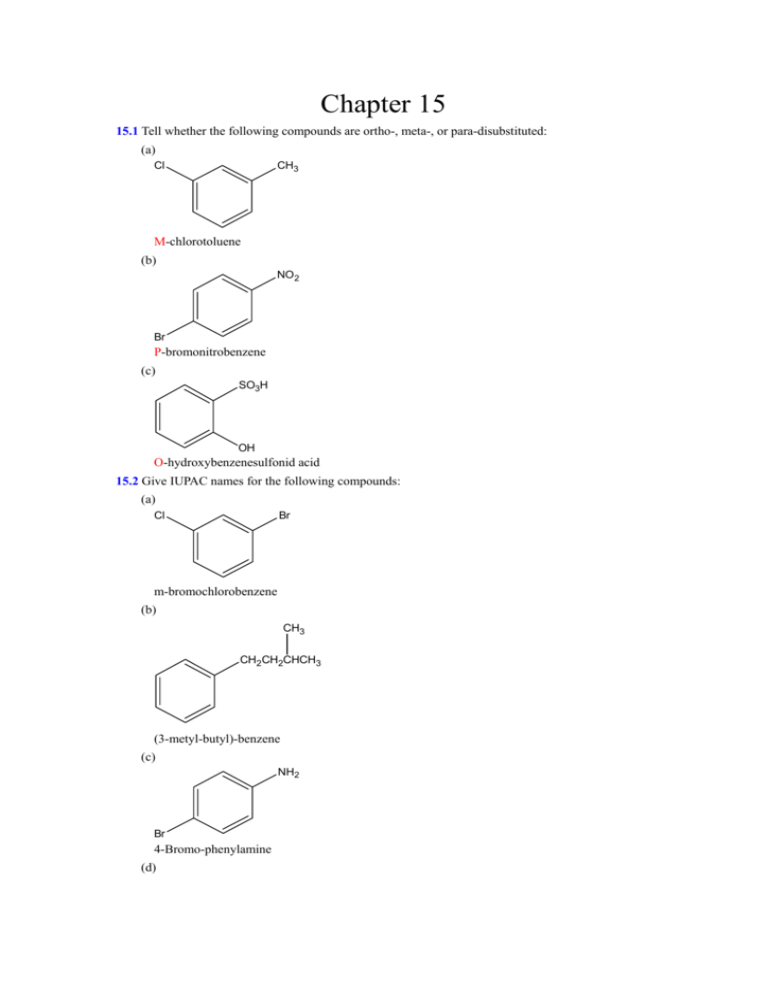
Chapter 15 15.1 Tell whether the following compounds are ortho-, meta-, or para-disubstituted: (a) Cl CH3 M-chlorotoluene (b) NO2 Br P-bromonitrobenzene (c) SO3H OH O-hydroxybenzenesulfonid acid 15.2 Give IUPAC names for the following compounds: (a) Cl Br m-bromochlorobenzene (b) CH3 CH2 CH2CHCH3 (3-metyl-butyl)-benzene (c) NH2 Br 4-Bromo-phenylamine (d) Cl CH3 Cl 2,5-dichlorotoluene (e) CH2 CH3 O2 N NO 2 2,4-dinitro-ethylbenzene (f) CH3 CH3 H3 C CH3 2,4,6-trimethyltoluene 15.3 Draw structures corresponding to the following IUPAC names: (1) p-Bromochlorobenzene Cl Br (2) p-bromotoluene H3C Br (3) m-chloroaniline H2N Cl (4) 1-Chloro-3,5-dimethyibenzene CH3 Cl H3C 15.4 Pridine is a flat, hexagonal molecular with bond angles of 120。. It undergoes electrophilic substitution rather than addition and generally behaves like benzene. Draw a picture of the π orbitals of pyridine to explain its properties . Check your answer by looking ahead in Section 15.7. N Pyridine Solutions: Because the N is sp2 hybridized ,so it can donate a electron to conjugate. six p atomic orbitals ψ2 ψ3 ψ1 ψ1 ψ2 ψ3 15.5 To be aromatic, a molecule must have 4n+2 Π electrons and must have cyclic conjugation. Cyclodecapentaene, shown below, fulfills one of these criteria but not the other, and has resisted all attempts at synthesis. Explain. Solution: H H Cyclodecapentaene has 4n+2 electrons, but it is not flat. If cyclodecapentaene were flat, the hydrogen atoms would crowed each other across the ring. To avoid this interaction, the molecular is distorted from planarity. 15.6 Draw the five resonance structures of the cyclopentadienyl anion. Are all carbon-carbon bonds equivalent? How many absorption lines would you expect to see in the 1H NMR and 13 C NMR spectra of the anion? Solution: H H (a) (b) H H (c) (d) H (e) Both proton NMR and carbon NMR show single absorption. 15.7 Cyclooctatetraene readily reacts with potassium metal to form the stable cyclooctatetraene dianion, C8H82-. Why do you suppose this reaction occurs so easily? What geometry do you expect for the cyclooctatetraene dianion? 2K 2K Solution: It’s aromatic and flat. 15.8 Draw an orbital picture of furan to show how the molecule is aromatic. O Solution: H H H H 15.9 The aromatic five-membered heterocycle imidazole is important in many biological processes. One of its nitrogen atoms is pyridine-like in that it contributes one л electron to the aromatic sextet, and the other nitrogen is pyrrole-like in that it contributes two л electrons. Draw an orbital picture of imidazole, and account for its aromaticity. Which nitrogen atom is pyridine-like, and which is pyrrole-like? Which nitrogen atom is more electron-rich, and why? N N H Solution: H N H N H H The singly bonded nitrogen is pyrrole-like, and the doubly bonded nitrogen is pyridine-like. The doubly bonded nitrogen is more electron-rich, because it has two lone pair electrons. 15.10 Show the relative energy levels of the senven л molecular orbitals of the cycloheptatrienyl system. Tell which of the seven orbitals are filled in the cation, radical, and anion, and account for the aromaticity of the cycloheptatrienyl cation. Solution: CH+ cycloheptatrienyl cation CH• cycloheptatrienyl radical CH- cycloheptatrienyl anion Cycloheptatrienyl cation has six л electrons, and the 4n+2 Rule is applicable, so it is aromatic. 15.11 Azulene, a beautiful blue hydrocarban, is an isomer of naphthalene. Is azulene aromatic? Draw a second resonance form. Solution: It is aromatic. 15.12 Naphthalene is sometimes represented with circles in each ring to represent aromaticity. How many ∏ electrons are in each circle? Solution: 5 15.13 Give IUPAC name for the following substances (red = O, blue = N): (a) (b) Solution: (a) m-isopropylphenol (b) o-nitrobenzoic acid 15.14 All-cis cyclodecapentaene is a stable molecule that shows a single absorption in its 1H NMR spectrum at 5.67δ. Tell whether it is aromatic, and explain its NMR spectrum. All-cis cyclodecapentaene Caution: Stereochemical terms discarded: allcis Solution: cyclodecapentaene has 10 electrons, thus fulfills the 4n+2 rule, but ten carbons are not in a planar, and can’t form cyclic conjugation system, so it is not aromatic. A single absorption at 5.67δ shows the characteristic of an alkene. 15.15 1,6-Methanonaphthalene has an interesting 1H NMR spectrum in which the eight hydrogens around the perimeter absorb at 6.9 to 7.3δ while the two CH2 protons absorb at –0.5δ. Tell whether it is aromatic, and explain its NMR spectrum. 1,6-Methanonaphthalene Solution: There are 10π electrons in the molecular. according to Hückel 4n+2 rule ,it is aromatic. The hydrogens of CH2 are equivalent and form a circular electricity in the ring. so the peak appear upfield. And the other hydrogens outward the ring have similar but not same chemistry environment, so they have different chemical shift and multiplet in downfield. 15.16 The following molecular model is that of a carbocation. Draw two resonance structures for the carbocation, indicating the positions of the double bonds. Solution: H H H H H H H H H H H H H H H H H H 15.17 Azzulene, an isomer of naphthalene, has a remarkably large dipole moment for a hydrocarbon. Explain, using resonance structures. 15.18 Give IUPAC names for the following compounds: CH3 CH3 CHCH2CH2CHCH3 (1,4-Dimethylpentyl)benzene (a) CO2H (b) Br m-Bromobenzoic acid Br (c) H3C 1-Bromo-3,5-dimethylbenzene CH3 Br CH2CH2CH3 (d) o-Bromopropylbenzen F NO2 (e) 1-Fluoro-2,4-dinitrobenzene NO2 NH2 (f) Cl p-Chloroaniline 15.19 Draw structures corresponding to the following names: (a) 3-Methyl-1,2-benzenediamine (b) 1,3,5-benzenetriol (c) 3-Methyl-2-phenylhexane (d) o-Aminobenzoic acid (e) m-Bromophenol (f) 2,4,6-Trinitrophenol(picric acid) (g) p-Iodonitrobenzene Solution: (a) H2N H2N 3-Methyl-1,2-benzenediamine (b) OH HO OH 1,3,5-benzenetriol (c) 3-Methyl-2-phenylhexane (d) H2N O HO o-Aminobenzoic acid (e) Br OH m-Bromophenol (f) O N+ O- N+ O- -O N+ O HO O 2,4,6-Trinitrophenol (g) -O N+ I O p-Iodonitrobenzene 15.20 Draw and name all possible isomers of the following: (a) Dinitrobenzene (b) Bromodimethylbenzene (c) Trinitrophenol Solution: (a) NO2 NO2 NO2 NO2 NO2 o- Dinitrobenzene (b) m- Dinitrobenzene NO2 p- Dinitrobenzene Br Br 1,5-Dimethylbromobenzene 2,3-Dimethylbromobenzene Br Br 2,5-Dimethylbromobenzene 2,4-Dimethylbromobenzene Br Br 3,5-Dimethylbromobenzene 3,4-Dimethylbromobenzene (c) OH OH NO2 NO2 OH NO2 O2N O2N NO2 NO2 NO2 NO2 2,3,4-trinitrophenol 2,3,6-trinitrophenol 2,3,5-trinitrophenol OH OH OH NO2 O2N NO2 O2N O2N NO2 2,4,5-trinitrophenol NO2 2,4,6-trinitrophenol NO2 NO2 3,4,5-trinitrophenol 15.21 Draw and name all possible aromatic compounds with the formula C7H7Cl. SOLUTION: CH3 CH3 CH2Cl CH3 Cl Cl Chloromethylbenzene o-Chlorotoluene Cl m-Chlorotoluene p-chlorotoluene 15.22 Draw and name all possible aromatic compounds with the formula C8H9Br. SOLUTION: Br CH2CH2Br CH2CH3 CH2CH3 H3CHC Br Br 2-Bromoethylbenzene 1-Bromoethylbenzene 2-bromo-1-ethylbenzene 3-bromo-1-ethylbenzene CH3 CH2CH3 CH3 CH2Br CH2Br Br 4-Bromo-1-ethylbenzene 1-Bromomethyl-2-methylbenzene 1-Bromomethyl-3-methylbenzene CH3 CH3 CH3 CH3 CH3 Br Br CH2Br 1-Bromomethyl-4-methylbenzene 3-Bromo-1,2-dimethylbenzene 4-bromo-1,2-dimethylbenzene CH3 CH3 Br Br CH3 CH3 2-bromo-1,3-dimethylbenzene 1-bromo-3,5-dimethylbenzene CH3 CH3 Br CH3 Br 1-bromo-2,4-dimethylbenzene CH3 2-bromo-1,4-dimethylbenzene 15.23 Propose structures for aromatic hydrocarbons the meet the following descriptions: a) C9H12; gives only one C9H11Br product on substitution with bromine b) C10H14; gives only one C10H13Cl product on substitution with chlorine c) C8H10; gives three C8H9Br products on substitution with bromine d) C10H14; gives two C10H13Cl products on substitution with chlorine Solution: a) b) c) d) 15.24 Look at the three resonance structure of naphthalene shown in section 15.9, and account for the fact that not all carbon-carbon bonds have the same length. The C1-C2 bond is 136 pm long, whereas C2-C3 bond is 139 pm long. Solution: 8 7 6 5 1 9 2 10 3 4 The bond between C1 and C2 is represented as a double bond in two of three resonance structures, but the bond between C2 and C3 is represented as a double bond in only one resonance structure. The C1-C2 bond thus has more double bond charater in the resonance hybrid, and it is shorter than the C2-C3 bond. 15.25 There are four resonance structures for anthracene, one of which is shown. Draw the other three. Anthracene Solution: 15.26 There are five resonance structures of phenanthrene, one of which is shown. Draw the other four. Phenanthrene Solution: 15.27 Look at the five resonance structures for phenanthrene (Problem 15.26) and predict which of its carbon-carbon bonds is shortest. Solution: 9 10 8 1 2 7 6 4 5 3 Phenanthrene Above are the five resonance structures for phenanthrene, from them we can see that the bond between carbon 9 and carbon 10 is the shortest. o 15.28 Use the data in Figure 15.2 to calculate the heat of hydrogenation, △H hydrog , for the partial hydrogenation of benzene to yield 1,3-cycloexadiene. Is the reaction exothermic or endothermic? Solution: H2/Pt △Hohydrog =+ 24kJ/mol The reaction is endothermic. 15.29 In 1932, A.A. Levine and A.G. Cole studied the ozonolysis of o-xylene and isolated three products: glyoxal, 2,3-butanedione, and pyruvaldehyde: CH3 CH3 1.O3 2.Zn H O O C C H + H3C Glyoxal O O C C CH3 + H3C 2,3-Butanedione O O C C H Pyruvaldehyde In what ratio would you expect the three products to be formed if o-xylene is a resonance hybrid of two structures? The actual ratio found was 3 parts glyoxal, 1 part 2,3-butanedione, and 2 parts pyruvaldehyde. What conclusions can you draw about the structure of o-xylene. Solution: The actual ratio found was 3 parts glyoxal, 1 part 2,3-butanedione, and 2 parts pyruvaldehyde. CH3 CH3 CH3 The structure of o-xylene is CH3 and 15.30 3-Chlorocyclopropene, on treatment with AgBF4, gives a precipitate of AgCl and a stable solution of a product that shows a single 1H NMR absorption at 11.04 δ. What is alikely structure for the product, and what is its relation to Hückel’s rule? H Cl 3-Chorocyclopropene . The resonance Solution: the product is structures of cation indicate that all hydrogen atoms are equivalent, and show only one absorption in NMR. Chemical shift of 11.04 δ indicate the aromatic system according to the Huckel rule. 15.31 Draw an energy diagram for the three molecular orbitals of the cyclopropenyl system (C3H3). How are these three molecular orbitals occupied in the cyclopropenyl anion, cation. and radical? Which of the three substances is aromatic according to Huckel’s rule. Anion Cation Radical According to Huckel’s rule,cyclopropenyl cation is aromatic. 15.32 Cyclopropanone is highly reactive because of its large amount of angle strain. Methylcyclopropenone, although more strained than ayalopropanone, is nevertheless quite stable and can even be distilled. Explain, taking the polarity of the carbonyl group into account. O O Cyclopropanone Solusion: Methylcyclopropenone O O O The first resonance structure is a cyclic conjugated system with two electrons, it is aromaticity based on Huckel rule. 15.33 Cycloheptatrienone is stable, but cyclopaentadienone is so reactive that it can’t be isolated. Explain, taking the polarity of the carbonyl group into account. O O Cycloheptatrienone cyclopaentadienone Solution: O O O O The resonance structure for cyclopentadienone is aromatic based on Huckel rule with 6 electrons. 15.34 Which would you expect to be most stable, cyclononatetraenyl radical, cation, or anion? Solution: According to Hückel’ rule, we can easily judge that cyclononatetraenyl anion is most stable. Hückel’ rule tells us that a aromatic contains 4n+2 π electrons are the most stable. while cyclononatetraenyl anion contains 10 electrons. cyclononatetraenyl radical cyclononatetraenyl cation H•C CH+ 9 electron cyclononatetraenyl anion 8 electron CH- 10 electron 15.35 How might you convert 1.3.5.7-cyclononatetraene to an aromatic substance? Solution: It has 8 π electrons in The structure of 1.3.5.7-cyclononatetraene is showed as follow: the planer π system, if we let the 1.3.5.7-cyclononatetraene lost a proton at 9 position, the carboanion structure has a 10 π electrons in the planer π system, than it is a aromatic structure. 15.36 Calicene, like azulene (Probllm15.17), has an unusually large dipole moment for a hydrocarbon. Explain, using resonance structure. Solution: The resonance structure shows that it has a six-π-electron (4*1+2) anion and a two-π- electron (4*0+2) cation, this system is more stable but has an unusually large dipole moment obviously. 15.37 Pentalene is a most elusive molecule and has never been isolated. The pentalene dianion, however, is well known and quite stable. Explain. 2- Pentalene Pentalene dianion Solution: The pentalene has 8 Π electrons and doesn’t obey the 4n+2 rule, so it is antiaromatic and highly reactive. The pentalene dianion has 10 Π electrons and obey the Huckel 4n+2 rule, so it is aromatic and quite stable. 15.38 Indole is an aromatic heterocycle that has a benzene ring fused to a pyrrole ring. Draw an orbital picture of indole. (a) How many π electrons does indole have? (b) What is the electronic relationship of indole to naphthalene? N H indole Solution: orbital picture: (a) 10π electrons (b) Since they both have 10π electrons, indole also has the aromatic stability as naphthalene has. 15.39 On reaction with acid, 4-pyrone is protonated on the carbonyl-group oxygen to give a stable cationic product. Using resonance structures and the Huckel 4n+2 rule, explain why the protonated product is so stable. O O H H+ O O 4-pyrone Solution: Resonance structures of the product are: H H H O O O O O O The orbital picture of the product is: O H H O O O O O From the resonance structures we can see the positive charge is not located in one certain atom. On the other side, from the orbital picture we can know that the oxygen atom is sp2-hybridized and has a lone pair of electrons in a p orbital perpendicular to the plane of the ring. At the same time the oxygen atom also has a second lone pair of electrons in the ring plane while one of the carbon atoms does not contributes any π electrons. So this molecular totally has six π electrons. This makes the product stable. 15.40: Compound A, C8H10, yields three substitution products, C8H9Br, on reaction with Br2. propose two possible structures for A. The 1H NMR spectrum of A shows a complex four-proton multiplet at 7.0σand a six-proton singlet at 2.30σ. What is the structure of A? Solution: As there are three kinds of products, so there are three kinds of protons. And it shows A shows a complex four-proton multiplet at 7.0σand a six-proton singlet at 2.30σ. So the structure of A should be: 15.41 N-Phenylsydnone, so-named because it was first studied at the University of Sydney, Australia, behaves like a typical aromatic molecule. Explain, using the Hückel 4n+2 rule. H O H O N O N O N N Solution: The second resonance form of N-phenylsydnone shows the aromaticity acoording to Huckel rule. 15.42: 1-Phenyl-2-butene has an UV absorption at 208nm. On treatment with a small amount of strong acid, isomerization occurs and a new substance at 250is formed. Propose a structure for this isomer, and suggest a mechanism for it. Solution: Isomer is 1-Phenyl-1-butene. Mechanism as follows: H H _ H 15.43 What is the structure of a hybrodrocarbon that has M+=120 in its mass specture and has the following 1H NMR specture? 7.25δ (5H, broad singlet); 2.90δ (1H, septet,J=7Hz); 1.22δ(6H,doublet,J=7Hz) Solution: H3C CH3 CH 15.44 Propose structures for compounds that fit the following descriptions: (a) C10H14 1 H NMR: 7.18δ(4H,broad singlet); 2.70δ(4H,quartet,J=7 Hz); 1.20δ(6H,triplet,J=7 Hz) IR: 745cm-1 (b) C10H14 1 H NMR :7.0δ(4H,broad singlet); 2.85δ(1 H,septet,J=8 Hz); 2.28δ(3 H,singlet); 1.20δ(6 H,doublet,J=8 Hz) IR: Solution: 825cm-1 (a) (b) 15.45 Propose structures for aromatic compounds that have the following 1H NMR spectra: IR: 820 cm-1 (a) C8H9Br 8 7 6 5 PPM 4 3 2 1 0 4 3 2 1 0 4 3 2 1 0 IR: 750 cm-1 (b) C9H12 8 7 6 5 PPM IR: 820 cm-1 (c) C11H16 8 7 Solution: (a) Br 6 5 PPM (b) (c) 15.46 Propose a structure for a molecule C14H12 that has the following 1H NMR spectrum and has IR absorptions at 700, 740, and 890cm-1 Solution: 15.47 Derivatives of the aromatic heterocycle purine are constituents of DNA and RNA. Why is purine aromatic? How many p electrons does each nitrogen donate to the aromatic π system? N N N Solution: N H Explanation: N N N H N 3 1 N N N H4 N 2 The nitrogen atoms 1,2 and 3's lone pair electrons are located in sp2 hybridized orbital, and one single electron is located in the p orbital. Nitrogen atom4 is sp2 hybridized and donate electrons pair to the pi system. 15.48 Aromatic substitution reaction occur by addition of an electrophilic such as Br+ to the aromatic ring to yield an allylic carbocation intermediate, followed by loss of H+. Show the structure of the intermediate formed by reaction of benzene with Br+. Solution: Br Br Br Br 15.49 The substitution reaction of toluene with Br2 can, in principle, lead to the formation of three isomeric bromotoluene products. In practice, however, only o- and p-bromotoluene are formed in substantial amounts. The meta isomer is not found. Draw the structures of the three possible carbocation intermediates, and explain why orthor and para products predominate over meta. Solution: Br Br Br Br most stable Br+ Br Br Br Br most stable Br Br




